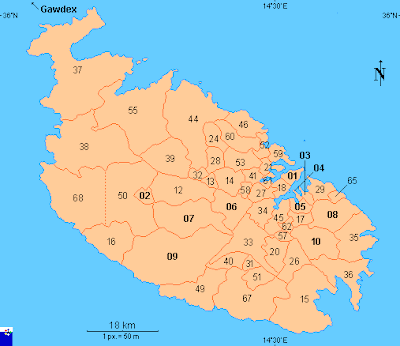

Today Malta celebrates the shipwreck of St.Paul to our islands.
St.Paul's Bay is found in the northern part of the island (no. 55 showing on the map). Birzebbuga the town where I come from is found in the southern part of the island (no.15). To give you an idea how small Malta is, to drive from my town up to St.Paul's town it will take not more than 45 minutes.
In the year 60 AD an event took place that is comprehensively described in the Bible: the shipwreck of the apostle Paul (Acts of the Apostles 27 and 28) . According to the legend this shipwreck took place at St. Paul's Bay. Saint Paul stayed in Malta for three months and performed a number of miracles, like the healing of the father of Publius, the Roman governor. Publius became the first bishop of Malta. Tradition has it, that St. Paul converted the Maltese to christianity, but there is no historical evidence to prove it. The first signs of the existence of a christian community in Malta date back to not earlier than the fourth century. Nevertheless Saint Paul is regarded as the one who brought christianity to Malta; Saint Paul is the patron saint of Malta and the cathedral of Mdina is dedicated to him.
The shipwreck of St. Paul in 60 AD is recorded in some detail in the Acts of the Apostles, and a Pauline tradition of long standing supported by archeological excavations carried out at San Pawl Milqghi prove beyond doubt that his arrival in Malta is a historical fact and it is also a fact that during his three-month stay on the Island he sowed the first seeds of the Christian Religion to which Maltese people overwhelmingly belong, but inevitably, a number of legends have grown up over the centuries, some verging on the impossible, but others not without a grain of truth.
The Apostle Paul was, at this time, being conducted to Rome under arrest to be judged before Caesar as was his right as a Roman Citizen. Amongst the other prisoners was the physician St. Luke who recorded the account of that eventful journey.
The nearest habitation to the place of shipwreck was the villa of Publius, the Chief Man of the Island. All those who had been shipwrecked spent three days there and after they had regained their strength they moved on to Melita the chief town of rile island. In the city Paul cured Publius' father of a fever after which the Chief Man of the Island was converted to Christianity and later ordained Bishop by St. Paul. St. Publius was the first bishop of Malta. After three months, by which time, the sea was again reckoned to be safe for navigation, and loaded with gifts from his Maltese friends, Saint Paul sailed away to Rome and to his subsequent martyrdom. When the Roman Emperor Constantine embraced Christianity and made it the official religion of the Empire it may be assumed that Christian worship was better organized and that a number of places of assembly were built in various places in the islands. Tradition has it that one such church was built on the site of the palace of Publius, where St. Paul had cured the father of the Chief Man of the Island. Many times rebuilt, the site is now occupied by the Cathedral Church dedicated to Saint Paul at Mdina.







